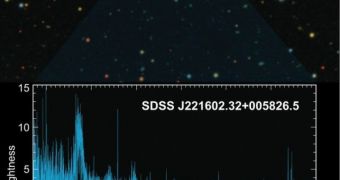Understanding the current state of the Universe has less to do with analyzing the way things are now, and more to do with finding out how things were in the early days, when the first galaxies and black holes appeared from the chaos that existed after the Big Bang. For this very purpose, experts with the Sloan Digital Sky Survey III are using advanced, extremely sensitive spectrographs, which can look into the very heart of the Universe, back to a time when the earliest galaxies started forming.
The cosmic expansion has pushed the light coming in from these earliest sources into the far-infrared spectrum, but the new instruments are especially suitable for observations in these wavelengths. The Baryon Oscillation Spectroscopic Survey (BOSS) was, in fact, created by the very need of observing these light sources and assessing their properties. This type of knowledge could hint at why galaxies behave the way the do today, astrophysicists say. By 2014, BOSS will have surveyed as much as 1.4 million galaxies, alongside 160,000 quasars (distant galaxies with active galactic nuclei).
In the night of September 14-15, one such instrument made its first observations. The spectrograph is mounted on the 2.5-meter telescope at Apache Point, in New Mexico, the US. “The light spectra look remarkably good. With these instruments we are looking back to a time when galaxies and their black holes were much more active than they are today,” expert Guinevere Kauffmann says. She holds an appointment at the Max Planck Institute for Astrophysics in Garching, near Munich, Germany. The scientist says that she and her group have been involved in the SDSS initiatives for seven years.
The BOSS relies on a sophisticated technology that actually tracks down the interactions between gravity and radiation pressure, which are known as baryon oscillations. These “waves” can compress matter, physicists say. They traveled at about half the speed of light immediately after the Big Bang, but are believed to have simply “frozen” just a few hundreds of thousands of years later, as temperatures in the Cosmos dropped following its expansion, PhysOrg reports.
“These frozen waves can be seen in the distribution of the galaxies today. By studying the baryon oscillations we can draw inferences about the nature of dark energy,” University of Arizona in Tucson (UAT) scientist Daniel Eisenstein says. “We expect the best ever data obtained on the large-scale structure of the universe,” Lawrence Berkeley National Laboratory (Berkeley Lab) expert David Schlegel, the principal investigator of the survey, concludes.

 14 DAY TRIAL //
14 DAY TRIAL //